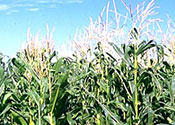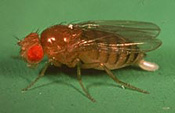La cantidad de flujo génico que se produce entre las poblaciones varía mucho en función del tipo de organismo.
Como cabría esperar, las poblaciones de organismos relativamente sedentarios están más aisladas entre sí que las poblaciones de organismos con gran una movilidad.

Tasa más baja de flujo génico
Es poco probable que el maíz, cuya polinización se hace por el viento, fecunde individuos que se encuentren a más de quince metros.

Tasa más alta de flujo génico
No obstante, otros organismos son capaces de repartir sus genes mucho más lejos. Por ejemplo, moscas de la fruta liberadas en Death Valley fueron capturadas de nuevo a casi quince kilómetros del lugar de liberación.
El flujo génico tiene varios efectos importantes en la evolución:
- Dentro de una población
Puede introducir o reintroducir genes en una población, haciendo que aumente su variabilidad genética. - Entre poblaciones
Al trasladar los genes de un lado a otro, puede hacer que poblaciones distantes sean similares genéticamente entre sí, reduciendo así la probabilidad de especiación. Cuanto menor sea el flujo génico entre dos poblaciones, más probable será que evolucionen en dos especies.
Original translation by the Spanish Society of Evolutionary Biology; translation editing by Maya deVries
